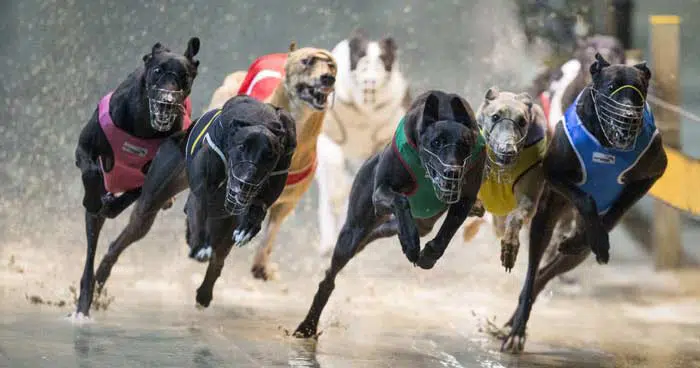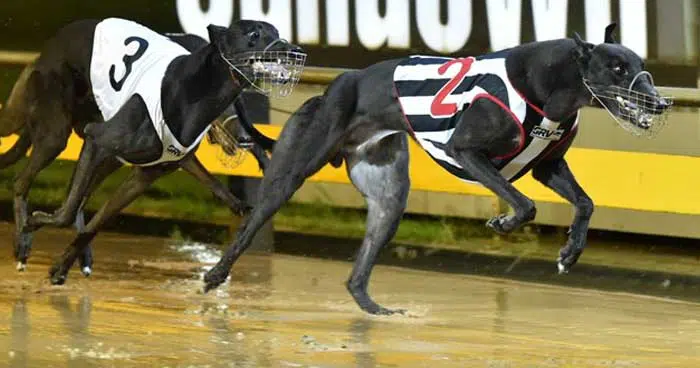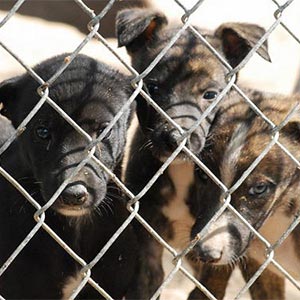Races take place in dangerous conditions
Greyhounds race year-round at some racetracks - on the hottest days of summer and the coldest days of winter.
This was acknowledged in February of 2010 by a legislative agent representing Bluff’s Run in Iowa:

We race 301 days a year. If you look outside and think about the weather right now, we’ll have dogs running tonight with no one there. We have dogs running all week, rain, snow, ice, you name it.

For every race, the track’s surface is officially marked as having one of four conditions: fast, normal, slow, and wet. A “Fast track” designation refers to races in hot temperatures, while “Slow track” refers to races in cold temperatures. “Wet track” refers to races after a rain has soaked the track, and a “Normal track” refers to races in normal track conditions. The gambling website Greyhound Predictor claims that while tracks attempt to provide a “fair and safe circuit for racing… this can be a difficult task to achieve as ‘track surfaces’ are constantly affected by adverse weather conditions.”
Extreme weather conditions lead to injuries and death. In May 2014 after racing at Florida’s Pensacola Greyhound Track, a dog named KB’s Greer was examined by the track veterinarian who determined “the greyhound was suffering from heat exhaustion and the greyhound’s organs had begun to shut down.” The 20-month-old greyhound was subsequently destroyed. In May 2008 after racing at Iowa’s Dubuque Greyhound Park, greyhound Pat C Make It suffered a broken leg due to a “sloppy track” caused by heavy rains. Weather can even affect a greyhound’s welfare outside of racing. In 2015 at the Florida Kennel Compound in Hialeah, trainer Jorge Esquivel reported his greyhound Rockdown Ben had died due to “overheating.”
Hot weather known to be dangerous
Greyhounds have been known to race in extreme heat, and racing in hot weather is of particular concern because greyhound body temperatures rise when racing. A 2016 Australian study of 229 racing greyhounds showed that the core body temperature after racing increased considerably by more than 2 °C from normal body temperature up to or equal to the critical level of 41.5 °C (106.7 °F) when the outside temperature is 31.2 °C (88.2 °F). With hot weather policies inconsistent across states in Australia, the Coalition for the Protection of Greyhounds has called for a temperature cap of 31 °C (87.8 °F) for racing and for pre- and post-racing cooling measures to be implemented in order to ensure greyhound temperatures do not reach dangerous levels.
The Society of Greyhound Veterinarians based in the UK has also suggested that serious consideration should be given to suspending racing if the temperature is in the region of 28 °C to 30 °C (82.4 °C to 86 °F). The RSPCA has also advised to keep dogs inside when temperatures hit 30 °C. Despite these expert recommendations, the Greyhound Board of Great Britain’s Hot Weather Policy only calls for postponing races when the temperature is in excess of 33 °C (91.4 °F).

In December 2016, the temperature reached 38 °C or over 100 °F, during the race meetings at the Casino track in New South Wales, Australia. In February 2023, following the tragic death of three-year old greyhound Weblac Gem in which the young dog collapsed and died immediately after running her race, the South Australian Greens called on the State Government to prohibit greyhound racing in temperatures over 38 °C (100.4 °F). In response, Greyhound Racing South Australia updated its Hot Weather Policy with immediate effect to require that races be rescheduled, relocated or canceled on days where the forecast projects temperatures will reach 38 °C or higher.
Similarly in Tasmania, Australia in 2024, the Tasmanian Greens and Animal Liberation Tasmania criticized the dog racing industry for putting profits before animal welfare after they pushed ahead with greyhound races during a heatwave.
In New Zealand, greyhound advocates recorded temperatures in dog trailers exceeding 30 °C (86 °F) in 2024 on days when greyhounds were hauled and raced in stifling humidity. Greyhound Racing New Zealand’s Hot Weather and Racing Policy only ensures meets are canceled if temperatures exceed 35 °C (95 °F).
The dog racing industry has also been criticized for racing greyhounds in hot conditions in the United Kingdom. In 2016, the RSPCA and Greyt Exploitations raised concerns after greyhounds were raced on the hottest day of the year at Perry Barr Stadium in Birmingham. In 2019, when temperatures were expected to breach 39 °C (102.2 °F), the League Against Cruel Sports and Greyt Exploitations called for races to be canceled. In 2022, the Greyhound Board of Great Britain allowed for dog races to continue even after the Met Office issued an amber alert for extreme heat.






Stay up to date and learn how you can help.